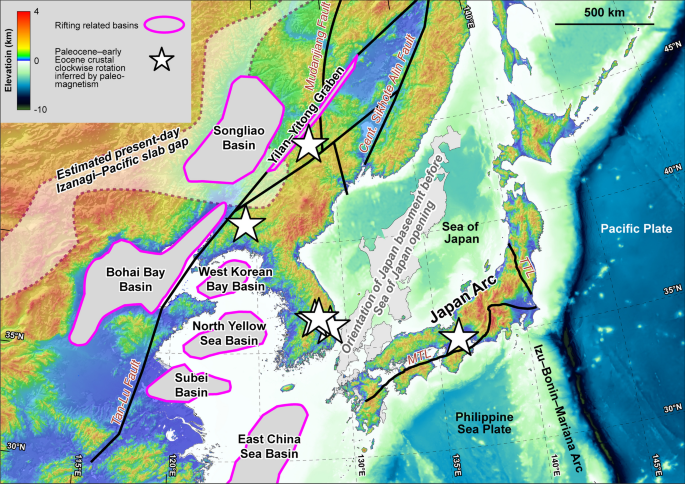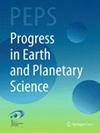日本西南部的顺时针旋转和弧移揭示的伊扎那吉-太平洋脊俯冲的时间
IF 2.8
3区 地球科学
Q1 GEOSCIENCES, MULTIDISCIPLINARY
引用次数: 0
摘要
与日本西南部白垩纪至古近纪火山弧相关的火成岩,在平行于构造中线的方向上,年龄从西向东为60岁,这表明了传统上用扩张脊的斜俯冲解释的热源的相应平移。然而,最近的大洋板块重建表明,洋脊俯冲可能比主弧活动更年轻。对日本弧长英质-中白垩统和新生代火成岩1227个测点的年龄汇编表明,弧岩浆活动可分为早期活跃期130-60 Ma(第1阶段),随后的静息期60-46 Ma(第2阶段),随后的火成岩活动从46 Ma开始恢复(第3阶段)。在日本西南部,第1阶段和第3阶段的岩浆弧方向显示出约20°的角不一致。活动弧岩浆活动的缺乏以及埃达克质和高镁安山岩岩浆的赋存模式表明,第2阶段发生了脊状俯冲。第1阶段弧年龄分布模式的解释是,随着脊的靠近,俯冲板块的年轻化导致了板块的变浅。此外,在第1阶段和第3阶段形成的弧的倾角可以用日本西南部内带在脊-俯冲阶段顺时针旋转20°来解释。洋板块重建显示,在脊状俯冲期后,洋板块向俯冲方向逆时针旋转,俯冲洋板块与上板块的耦合将支持内带微板块的旋转。新的构造重建为研究东亚边缘古近纪活动伸展脊的俯冲作用、花岗岩体的分布、欧亚大陆东缘裂谷相关盆地的形成以及白垩纪地体古地磁资料显示的地壳块体的旋转提供了框架。本文章由计算机程序翻译,如有差异,请以英文原文为准。

Clockwise rotation of SW Japan and timing of Izanagi–Pacific ridge subduction revealed by arc migration
Abstract Igneous rocks associated with the Cretaceous to Paleogene volcanic arc in SW Japan show ages that young from west to east in a direction parallel to the Median Tectonic Line suggesting corresponding translation of a heat source traditionally interpreted in terms of oblique subduction of a spreading ridge. However, recent oceanic plate reconstructions suggest ridge subduction may be younger than the main arc activity. Age compilations of 1227 points of felsic to intermediate Cretaceous and Cenozoic igneous rocks from the Japan arc show arc magmatism that can be separated into an early active period 130–60 Ma (stage 1), a subsequent period of quiescence 60–46 Ma (stage 2), which is followed by a resumption of igneous activity from 46 Ma onward (stage 3). In southwest Japan, the orientations of the magmatic arcs of stages 1 and 3 show and angular discordance of about 20°. The lack of active arc magmatism and the occurrence patterns of adakitic and high-Mg andesitic magmas indicate that ridge subduction occurred during stage 2. The arc age distribution pattern of stage 1 is explained by the slab shallowing related to a younging of the subducting slab as the ridge approaches. Furthermore, the obliquity of the arcs formed at stages 1 and 3 is explained by a 20° clockwise rotation of the inner zone of southwest Japan during the ridge-subduction phase. Oceanic plate reconstructions show counterclockwise rotation in the subduction direction after the ridge subduction phase, and coupling of the subducting oceanic plate with the upper plate would support microplate rotation in the inner zone. The new proposed tectonic reconstructions provide a framework to related Paleogene subduction of an active spreading ridge along the east Asia margin not only to the distribution of granitic bodies but also to rift-related basin formation on the eastern margin of the Eurasian continent and to rotation of crustal blocks indicated by paleomagnetic data of Cretaceous terranes.
求助全文
通过发布文献求助,成功后即可免费获取论文全文。
去求助
来源期刊

Progress in Earth and Planetary Science
Earth and Planetary Sciences-General Earth and Planetary Sciences
CiteScore
6.50
自引率
5.10%
发文量
59
审稿时长
31 weeks
期刊介绍:
Progress in Earth and Planetary Science (PEPS), a peer-reviewed open access e-journal, was launched by the Japan Geoscience Union (JpGU) in 2014. This international journal is devoted to high-quality original articles, reviews and papers with full data attached in the research fields of space and planetary sciences, atmospheric and hydrospheric sciences, human geosciences, solid earth sciences, and biogeosciences. PEPS promotes excellent review articles and welcomes articles with electronic attachments including videos, animations, and large original data files. PEPS also encourages papers with full data attached: papers with full data attached are scientific articles that preserve the full detailed raw research data and metadata which were gathered in their preparation and make these data freely available to the research community for further analysis.
 求助内容:
求助内容: 应助结果提醒方式:
应助结果提醒方式:


